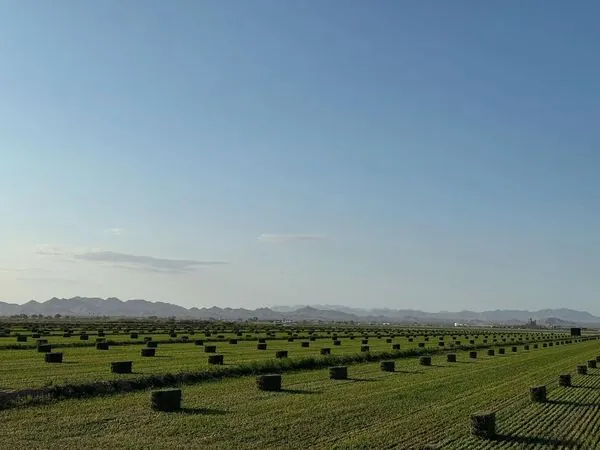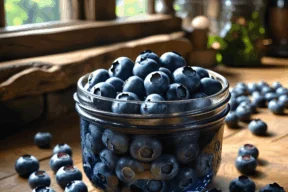Farm Facts That Feed You
Alfalfa Facts

A Forage Crop with Great History: Alfalfa Facts
Alfalfa represents a centuries-old history as a domesticated crop. According to archeologists, remains of this forage crop are more than 6,000 years old and have been found in Iran and all over the world. The robust history of alfalfa proves its stamina today.
The primary use of alfalfa is as feed for dairy cows, horses, sheep, beef, and other farm animals. In fact, for livestock producers, alfalfa is one of three key forage crops. Without it, many dairy cows would not receive the nutrition that they need.
Due to its high levels of protein content—among the highest per acre, compared to other forage crops, alfalfa has enormous feed value. And because it’s a legume—like peas and beans—it fixes nitrogen in the soil, rather than requiring it as a fertilizer.
In Arizona and California, alfalfa fields yield more than twice as many tons per acre as the national average, due primarily to climate, water management and other conditions.
Specific Facts About Alfalfa
- Nationally, alfalfa is one of the most commonly produced forage crops.
- Extremely palatable for livestock, alfalfa adds valuable fiber to our livestock’s diets.
- Alfalfa has a faster rate of fiber digestion than grasses (including corn silage). This allows the energy from fiber fractions to become available rapidly over 12 to 24 hours but not so rapidly as to acidify the rumen (as from grain).
- Alfalfa is high in protein. Protein is the most expensive component of most rations. Good-quality alfalfa runs 16 to 20% CP, while corn silage is 8 to 9% CP, and most grasses are 12 to 14% CP (grasses may be somewhat higher if harvested when immature). A milking dairy cow needs 16 to 17% CP and growing animals need 12 to 16% CP. Thus, alfalfa can go further in meeting the protein needs of animals than most other forages.
- Alfalfa provides needed minerals. It contains a greater concentration of calcium, phosphorus, potassium, magnesium, sulfur, iron, zinc, and selenium than grasses. It is a good source of calcium for all animals, especially horses.
- Alfalfa provides needed vitamins. Leafy, green alfalfa hay is unusually high in carotene, the precursor of vitamin A. Vitamin A is the most common beef cow vitamin deficiency. Good-quality alfalfa hay can furnish all the vitamin A needs of beef animals.
- Alfalfa is usually a good source of vitamin E and selenium, depending on the soil’s nutrient status on which the hay was grown.
- Alfalfa, with a higher natural buffering capacity and higher fiber level than corn silage, reduces the problem of ration adaptation when feed sources are changed.
- Alfalfa promotes animal health. The high mineral and vitamin content of alfalfa is very important to animal health.
- One Arizona alfalfa farmer, Nancy Caywood, says: “Alfalfa is milk chocolate in the making.”
Arizona Alfalfa
- Alfalfa hay has been exported from the Southern Arizona and Southern California deserts regularly since the early 1970s. Agriculture economies have almost always been subject to the free market fundamentals of supply and demand; produce where it is most feasible and deliver to where it is most valuable.
- Arizona is an excellent place to grow alfalfa because of our favorable climate that allows for up to 10 harvests of premium quality alfalfa per year, averaging at least 8 cuttings (compared to 3 to 4 in other areas of the United States).
- It’s estimated that 20% of Arizona alfalfa is sold for export; the majority is grown for local consumption.
- The demand for alfalfa in multiple foreign economies is higher than in America, enough to pay to have it shipped thousands of miles across an ocean.
- Only a small amount of the water used in producing alfalfa is exported. Most water is recycled as part of the water cycle, known as the hydrologic cycle. When you study and understand the hydrologic cycle, you understand that you can’t export water in the alfalfa crop.
- Without Arizona’s alfalfa crop, we could not support our two top agriculture commodities: Dairy and Beef
The Benefits of Arizona Alfalfa to the Southwest Ecosystem
As the southwest U.S. continues to endure the conditions of “megadrought,” or any other term that describes the shortage of water in our region, some are attributing alfalfa for some of this problem. The share of water going toward alfalfa hay production supports the dairy and livestock industry. This is not the only fact about alfalfa growing in the region.
Alfalfa in the southwest ecosystem provides many environmental benefits:
- it is a rich habitat for wildlife;
- provides an environment for diverse beneficial insects;
- improves soil characteristics;
- fixes atmospheric nitrogen;
- traps sediments and takes up nitrate pollutants;
- mitigates water and air pollution;
- and provides aesthetically pleasing open spaces.
- Alfalfa is a soil stabilizer because it’s a perennial legume, staying in the ground for several years: four to five.
- Alfalfa fields are important contributors to the biodiversity of agricultural systems by functioning as insectaries for beneficial insects, many of which are pollinators or natural enemies that play important roles in the low desert agroecosystem. Beneficial insects move from alfalfa fields into other crops, where they play crucial roles in pollination and biological control.
- Non-dormant alfalfa hay varieties are uniquely adapted to the low desert climates of central and southern Arizona and the adjacent region of California along the Colorado River. Unlike many other production regions in the nation, low desert alfalfa is irrigated and produces an average of eight cuttings every year. In the Midwest, it’s about 3 to 4 cuttings a year.
Ecosystem Source: Ayman M Mostafa, Ph.D., Interim Associate Director, Maricopa County, Area Programmatic Agent & Regional Specialist, Cooperative Extension & Dept. of Entomology, THE UNIVERSITY OF ARIZONA
Banking Water in Alfalfa
With the rain we received recently and much more in the forecast, I have been approached with some questions about the impacts of this water on alfalfa during the winter to establish a “water bank” during the summer. One of the practices in our desert environment is to apply more water to alfalfa during the winter to have “water in the bank” for later. This practice does have some merit for fields with deep soil if irrigation water is in short supply during the summer. Subsoil moisture can contribute to yield and stand survival when alfalfa is stressed for water. Alfalfa is a deep-rooted crop and can take up water from depths of 8 feet or more. Subsoil moisture at depths of 20 to 30 feet has been reported to contribute to alfalfa survival in drought years. With an active weather cycle and above-normal expectations of rain during this winter, growers need to be cautious to avoid excessive water that might affect alfalfa crop growth, especially during the premium winter/spring cuts. — Ayman M Mostafa, Ph.D., Interim Associate Director, Maricopa County, Area Programmatic Agent & Regional Specialist, Cooperative Extension & Dept. of Entomology, THE UNIVERSITY OF ARIZONA
In Defense of Alfalfa and Why It’s Core to our Local Food Supply
Alfalfa is often accused of using too much water (this is while we continue to improve our irrigation technology and reduce the amount of water we put on our crops).
This legume crop typically stays in the ground for as much as 4 to 5 years while undergoing repeated cuts per season, in Arizona we’re known to get as many as 10 cuttings in one year.
But did you know that the massive amounts of alfalfa you see across our farmlands are a wonderful sequester of carbon? Studies have found alfalfa sequesters very high amounts of carbon through its very deep root structure that can reach 10 to 15 feet and its natural growth and maturation processes.
And Bonus! Because it can stay in the ground for so long, the added benefit alfalfa contributes to our climate is massive. Remember plants take in carbon and breathe out oxygen for us.
“This is the type of agricultural economy we have in Arizona, where approximately 2% of the population produces 100% of the food and fiber,” says engineer and Ag consultant Nich Kenny. “Simplistically, the legitimate accounting of the water utilized in the process of raising the agricultural products lies with the 100%, not just the 2%.”
Sources: Arizona Farm Bureau, the University of Arizona and our forage farmers.
Our Videos
View all VideosOur Latest Posts

Nutrition for Cycling: How Proper Nutrition Fuels Cyclists from the First Mile to the Finish Line
Cycling is a sport built on rhythm, the turning of your pedals, the cadence of your breath, and the flow of your energy as the…

The Scoop on Salt
For the longest time I never understood why every baking recipe always called for a teaspoon or two of salt, even if the baked good…
Featured Recipes













